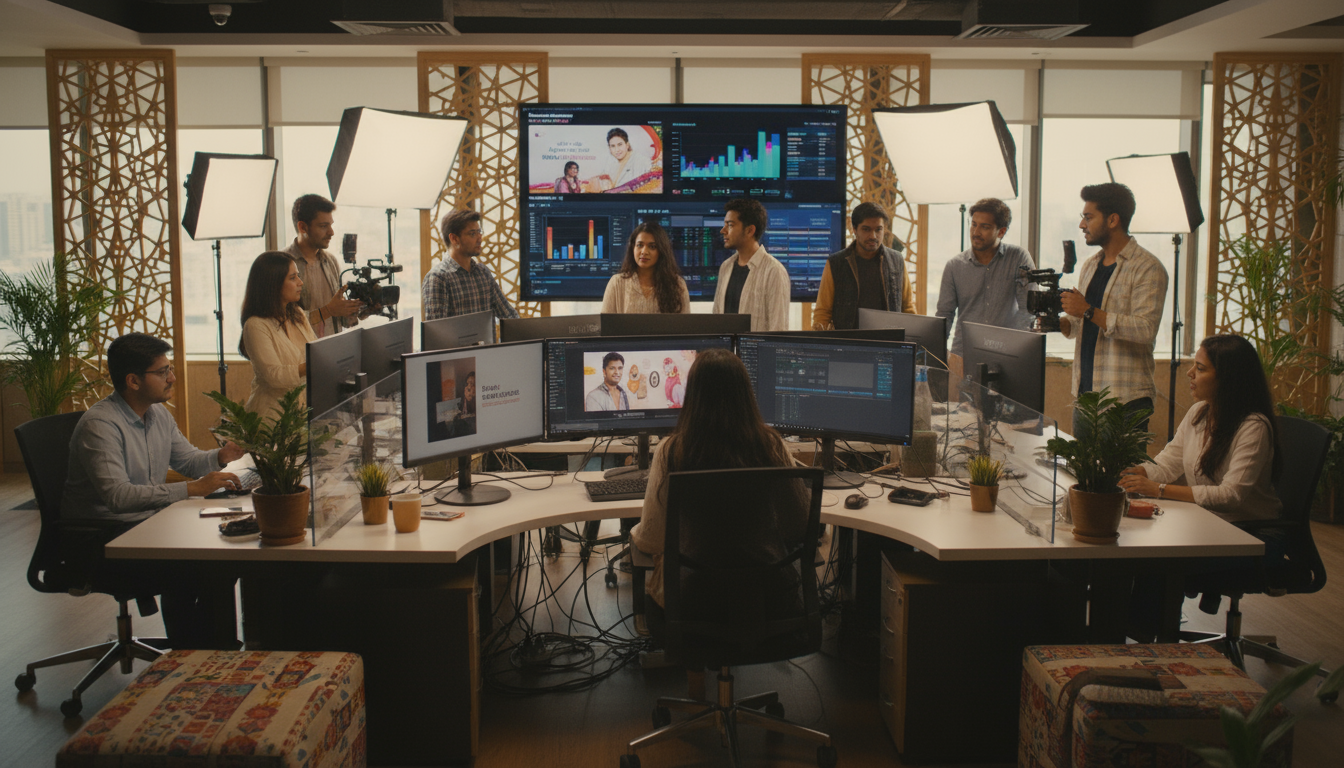In the dynamic world of marketing communications, the auditory experience—voiceovers and music—often separates the memorable from the forgettable. At Adomantra, a leading choice for a Video Advertising Agency India, we understand how voice and music are integral to the success of video-advertising projects. This blog post explores why voice and music matter, how they work in tandem, and how Indian agencies can harness them effectively—particularly in Indian market contexts.
1. Introduction: Why audio matters in video advertising
When brands collaborate with a Video Advertising Agency India such as Adomantra, they often focus first on visuals—storyboards, cinematography, casting. But increasingly, the role of audio (voice + music) is proving decisive in audience engagement, brand recall and emotional resonance. As one study puts it: “Music can affect audience emotions and make your ad memorable.”
In Indian video advertising projects, voice and music play especially important roles given the multilingual, multicultural audience and high level of media noise. A strong auditory identity can cut through clutter, anchor the brand message, and ensure it lingers in viewers’ minds.
This post will examine:
- The distinctive roles of voice and music
- How they collaborate in practice
- Specific considerations for India
- How Adomantra approaches them in its projects
2. The Power of Voice in Video Advertising
2.1 What “voice” means (tone, accent, language, narration style)
In a video ad, “voice” refers not just to what is said (script) but how it is delivered: the narrator’s tone, gender, accent, pace, intonation, language choice. A voice‐over artist might be used to narrate, explain or emotively convey a message.
For example, in India, choosing between a Hindi voice, English voice, regional language voice (Tamil, Malayalam, Marathi, etc.) is a strategic choice for a Video Advertising Agency India. The voice must match the brand personality, campaign goal, audience profile and sometimes the media placement (TV, digital, mobile).
2.2 Why voice matters in advertising
- Clarity of message: A well-selected voice ensures the viewer clearly understands the message, especially in short ad formats. For multilingual India, clarity becomes critical. Services offering commercial voice-overs in India emphasise “voice actors provide native recordings in a variety of languages… interpret not only words but also local characteristics.”
- Emotional resonance: The human voice is expressive. A calm, authoritative voice can instil trust; an energetic voice can instil excitement. This emotion translates to brand perception.
- Brand personality and trustworthiness: The voice becomes part of the brand’s persona. Just like visuals create identity, voice builds a consistent auditory brand identity.
- Accessibility and localization: In India’s diverse linguistic ecosystem, voice‐overs allow localisation—adapting to different regions and enabling deeper audience connection.
- Retention & recall: When the voice aligns with visuals, brand and music, the ad is more likely to stay in memory.
2.3 Key considerations for voice-overs in Indian video advertising projects
When a Video Advertising Agency India manages projects, here are voice-related factors to handle:
- Language & dialect: Choosing the appropriate language (Hindi, English, regional) and selecting the correct dialect/accent for authenticity.
- Tone & pacing: Should it be conversational, formal, dramatic, friendly? The pacing should match the visuals and the viewer’s context (mobile users, TV viewers, short social ads).
- Voice casting: Selecting a voice-over artist whose voice aligns with the brand’s ethos. For example, someone youthful for a Gen Z target, or someone authoritative for a premium brand.
- Script adaptation: In India, localization may require rewriting lines to suit cultural nuances rather than direct translation.
- Synchronization with visuals and music: The voice must integrate smoothly with the musical track and visuals—not fight for attention.
- Rights, usage & delivery: Ensuring proper contracts, rights for voice usage, languages, platforms, and high‐quality audio recording and mixing.
At Adomantra, we make voice selection an early step in our workflow because we know that the voice becomes the “audio face” of the ad—often remembered long after the visuals fade.
3. The Role of Music in Video Advertising
3.1 What music brings to video ads
Music in a video advertisement is far more than background filler. It sets mood, builds atmosphere, reinforces brand identity and even prompts action. According to one study: “In the world of advertising films, music and sound play a crucial role in capturing attention, evoking emotions, and enhancing brand recall.”
Another research article notes the use of pre‐existing music vs jingles, and the effect of music on memory and brand recall.
3.2 Why music matters
- Emotional trigger: Music taps into human emotions quickly; it can make viewers feel excited, nostalgic, hopeful or calm, depending on tempo, melody and instrumentation.
- Brand recall and identity: A unique sonic logo or consistent music style can serve as a mnemonic device. As one article states: “Music in advertising is ‘the most common musical technique for aiding memorability and hence product recall’.”
- Atmosphere and pace: Music drives narrative tempo. A fast beat conveys energy; a slower track suggests reflection or premium feel.
- Differentiation: In a crowded advertising environment, sound helps a brand stand out. Study findings show that good music choice can enhance distinctiveness, feel‐good factor and brand involvement.
- Cross‐platform consistency: As brands deploy video ads across TV, YouTube, mobile, OTT platforms, music provides a consistent audio identity.
3.3 Best practices for music selection in Indian video advertising
When a Video Advertising Agency India designs campaigns, music choices must consider:
- Cultural and regional relevance: India’s audience is diverse; music style should resonate with target demographic and region.
- Consistency with voice & visuals: The musical track should vacate sufficient audio space for voice‐over, not compete or clash.
- Original versus licensed music: Licensing a popular song may boost recall but may be costly. Some studies suggest that “use of pre‐existing music favours the memory of the ad over the use of jingles.”
- Sound design and effects: Music often works along with sound effects (SFX) and voice to create immersive experience.
- Platform context: On mobile/social media, many viewers may watch without sound. Study shows that on Facebook, a high percentage view with sound off, so music and sound must either entice enabling sound or function even muted.
- Budget and rights: Music must be cleared for the intended regions and platforms. Usage rights, cost, lifespan must be managed.
At Adomantra, we work with composers and music supervisors early in campaign development, ensuring that the music aligns with the brief, target audience, brand personality and deployment platform.
4. How Voice and Music Work Together in Indian Video Advertising Projects
4.1 The interplay between voice, music and visuals
In any video ad, three primary sensory channels converge: visuals, voice (or narration/dialogue), and music/sound design. Their interaction defines the audience experience. Here’s how they collaborate:
- Intro/Hook: The right musical intro or sonic logo combined with a compelling voice can grab immediate attention.
- Narrative unfolding: As the visuals tell the story, voice guides meaning and music supports mood.
- Climax & call to action: Music may swell, voice may move into urgent tone or emotive pitch; together they amplify the message.
- Brand signature: At the ad’s end, a sonic branding element (music cue + brand voice-over) reinforces identity and recall.
For a Video Advertising Agency India, orchestrating these elements is crucial for campaign effectiveness.
4.2 Indian market particularities
For Indian video advertising projects, some additional aspects matter:
- Language shift: Ads may be translated/localised into multiple regional languages. The voice selection must accommodate that, and the music must be culturally neutral or locally adapted.
- Diverse audience preferences: What resonates in urban metros may differ from smaller towns. A youth‐centric pop track may appeal to urban but not rural audiences; a regional folk element may work better in a local market.
- Multi-platform consumption: Indian audiences consume video on TV, mobile phones, OTT, social platforms. Music and voice need to be tailored for short-format mobile ads (6-15 seconds) as well as longer formats.
- Budget sensitivity: While premium brands can license popular music or hire top-tier voice artists, many campaigns must optimise cost. Therefore, agencies like Adomantra select voices cleverly and use music smartly for maximum impact within budget.
- Cultural nuance: Tone and style of voice must reflect local sensibilities—not just language, but accent, intonation, pace, values. Similarly, music needs to avoid cultural mismatch which can lead to dissonance or negative brand association.
4.3 Workflow at Adomantra (Video Advertising Agency India)
At Adomantra, our workflow for integrating voice and music in video advertising projects typically follows these phases:
- Briefing & strategy: Understand brand, target audience (region, language, device), campaign objective (awareness, consideration, conversion).
- Script & voice tone definition: Write the script, decide key lines and call-to-action, choose voice characteristics (gender, language/dialect, tone, pacing).
- Voice casting & recording: Engage voice-over artists, conduct auditions, record in professional studio, ensure clean takes, mix voice.
- Music & sound design concept: Define mood, tempo, instrumentation, whether original or licensed, any sonic logo.
- Temp mix & early cut: Combine rough visuals, voice track and placeholder music to test timing, rhythm, emphasis.
- Refinement: Adjust voice pacing to match visuals, trim or extend music cues, ensure voice vs music balance, refine SFX.
- Final mix & mastering: Deliver audio in correct formats for platforms, ensure levels comply, rights and clearances in place.
- Upload/deployment & tracking: Monitor performance across platforms, check audio engagement (especially for mobile/social where sound is often off).
- Learning & iteration: Use data (view rates, watch time, conversions) to tweak future campaigns’ audio strategies.
Because Adomantra functions as a Video Advertising Agency India, we combine creative audio work with local market insight—making voice and music assets not just “nice to have” but strategic.
5. Challenges & Solutions in Voice + Music for Indian Video Advertising
5.1 Common challenges
- Sound off culture: On mobile/social platforms, many users watch without sound—one study found ~85% view on Facebook without sound.
- Budget constraints: Licensing popular songs or hiring premium voice talents may be expensive.
- Cultural mismatch: Generic voice or music may fail to resonate with regional audiences.
- Overpowering audio: Music overpowering voice or visuals can confuse the message.
- Rights & localisation complexity: Multiple languages, regions, platforms mean multiple versions; rights must cover each usage.
- Platform adaptation: Audio designed for TV may not suit mobile screens or social formats; mixing and mastering need to adapt.
5.2 Solutions and best practices
- Design for the silent view: Ensure visuals + captions + on-screen branding carry the message even if audio is off, but still optimise audio for when sound is on.
- Use sonic branding: A short sonic logo or musical motif (2-3 seconds) that repeats across videos helps build recall even in short formats.
- Choose voice and music early: Audio decisions should happen early so they can influence editing and pacing rather than being tacked on late.
- Localise smartly: Use voice artists native to language/region; adapt music style subtly rather than simply reusing the same track for all regions.
- Optimise budgets: Use cost-effective tracks, perhaps buy rights to lesser-known but strong compositions, or create original music in-house rather than licensing big hits.
- Balance voice and music: During mixing ensure the voice remains intelligible, music complements but doesn’t overshadow.
- Test and iterate: Use data from previous campaigns; try A/B testing of voice/music variants to see what drives better engagement and recall.
At Adomantra, we embed these practices into our standard operating procedures for video advertising projects, thereby reducing risk and enhancing campaign effectiveness.
6. Case Study Snapshot (Hypothetical)
Imagine Adomantra working for a new smartphone brand targeting metropolitan India and Tier 2 cities. The campaign runs across TV and digital (YouTube, Instagram). Here’s how voice and music were handled:
- Brief: Youthful, aspirational, tech-savvy but accessible.
- Voice: Bilingual voice‐over (Hindi + English) with a friendly, confident male voice for metro ad; a male Hindi regional dialect version for Tier 2 city ad.
- Music: Upbeat electronic track with Indian instrumentation (tabla, sitar subtle elements) to reflect “global meets local”. A short 2-second sonic mnemonic is created for the brand.
- Silent-first design: On mobile ads, visuals carry headline and key features; voice adds flair when sound on.
- Mixing: For TV version, full articulation of voice and music; for digital cut, voice slightly upfront, music slightly toned down given smaller screens/speakers.
- Results: Higher recall and engagement in targeted demographics; voice and sonic motif recognised across platforms.
This kind of process demonstrates how voice + music decisions are not afterthoughts but central to campaign strategy at a Video Advertising Agency India like Adomantra.
7. Future Trends in Voice & Music for Indian Video Advertising
7.1 Increased localisation and regional audio assets
As Indian connectivity and consumption continues to grow in regional languages, agencies will increasingly build regional-language voice and music libraries rather than only national Hindi/English.
7.2 Shorter formats, smarter audio
With 6-15 second mobile video ads dominating, audio elements (voice & music) must deliver impact faster—e.g., sonic logos, shorter voice lines, music with immediate hook.
7.3 AI and custom music generation
Some research mentions the role of AI in creating customised music for ads—e.g., “AI-generated music … offering data-driven, tailored solutions for brands looking to enhance their advertising strategies.” For Indian agencies, this means more cost-effective custom music options.
7.4 Voice personalisation & interactive ads
As interactive video ads (OTT, shoppable video) increase, voice may need to incorporate dynamic content, regional dialect switching, and interactive prompts. Music may adapt in real time to viewer behaviour.
7.5 Stronger emphasis on audio branding
Beyond visuals, brands will invest more in “audio identities”—distinctive voices and sonic logos that consistently represent the brand across all video touchpoints. Music and voice will be as important as visual logos.
At Adomantra, we are already preparing voice/musical asset libraries and exploring AI-music tools to stay ahead of these trends within the Indian video advertising ecosystem.
8. Why Choosing the Right Video Advertising Agency India Matters – With a Focus on Audio
When a brand selects a Video Advertising Agency India, the decision often hinges on creative visuals and production values. Yet the agency’s approach to voice and music can profoundly affect campaign outcomes. Here’s what sets a top-tier agency like Adomantra apart:
- Audio strategy integrated early: Not treated as an afterthought but as a pillar of the brief.
- Market-specific audio insight: Understanding Indian regional languages, dialects, music sensibilities and viewer behaviour.
- Professional network: Access to quality voice talent and music composers/licence frameworks.
- Platform-aware mixing and deployment: Knowing how audio will be consumed (TV, mobile, OTT) and optimising accordingly.
- Rights & clearances management: Ensuring voice/musical rights are correct for India and all intended platforms.
- Measurement & iteration: Using audio metrics (engagement, recall, drop-off) to refine next campaigns.
By focusing on these areas, a Video Advertising Agency India can deliver not just videos, but memorable audio-visual experiences—and drive better brand impact and ROI.
9. Conclusion
In a media environment overloaded with visuals and messages, audio—via voice and music—offers a powerful differentiation for brands. For a Video Advertising Agency India like Adomantra, integrating voice and music meaningfully is not optional; it is central to campaign success.
Voice ensures the brand speaks in the right tone, language and context for its audience. Music underpins mood, memorability and brand identity. Together—with strategic planning, local insight and platform-aware execution—they create video advertising that resonates.
Read More: techners











Leave a Reply